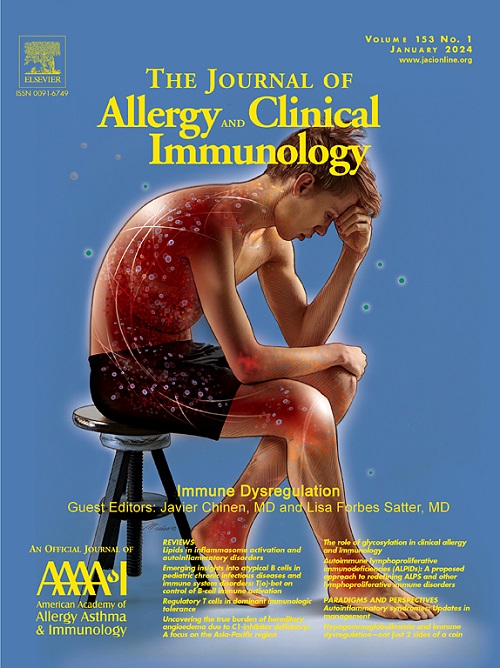慢性鼻窦炎伴鼻息肉患者炎症型对疾病发展轨迹的影响
IF 11.4
1区 医学
Q1 ALLERGY
引用次数: 0
摘要
虽然表型特征传统上指导慢性鼻窦炎(CRS)的治疗,但最近的研究倾向于基于炎症内型的分类。然而,内源性差异对临床结果的影响在很大程度上仍然未知。目的:我们旨在比较CRS和鼻息肉(CRSwNP)内分型的疾病发展轨迹,主要是到息肉复发的时间。方法从2015-2023年间接受手术的CRSwNP患者中获取样本,采用多重头法检测细胞因子水平。采用主成分分析和层次聚类分析鉴定内源性聚类。结果:我们在269例纳入的患者中确定了6个CRSwNP疾病集群。第1组(46.5%)的特点是相对较低的炎症。第4组(13.3%)和第6组(7.1%)也表现出低炎症,但白细胞介素(IL)-12/IL-21和CCL5水平分别升高。第2类(4.5%)为混合1/3型炎症内型(IFN-γ高/IL-4High/IL-17AHigh),第3类(10.0%)为先天促炎反应(il -1β高/IL-6High/IL-8High)。第5组(18.9%)表现为2型显性炎症(IL-5High/IL-9High/IL-13High)。比较疾病发展轨迹,聚类2 (IFN-γHigh/IL-4High/IL-17AHigh)和聚类4 (IL-12High/IL-21High)到息肉复发时间最短,聚类3 (IL-1βHigh/IL-6High/IL-8High)到息肉复发时间最长(p<0.001)。结论:我们的研究强调了CRSwNP的异质性和不同内型之间疾病发展的差异,特别是混合1型和3型炎症患者表现出更顽固性的疾病。这些发现表明,可能需要传统2型炎症治疗之外的治疗来有效减少CRSwNP疾病的复发。本文章由计算机程序翻译,如有差异,请以英文原文为准。
Effects of Inflammatory Endotypes on Disease Trajectory in Chronic Rhinosinusitis with Nasal Polyps.
BACKGROUND
While phenotypic features have traditionally guided treatment in chronic rhinosinusitis (CRS), recent research has favored categorization based on inflammatory endotype. However, the impact of endotypic differences on clinical outcomes remains largely unknown.
OBJECTIVE
We aimed to compare disease trajectory, primarily time-to-polyp recurrence, between CRS with nasal polyp (CRSwNP) endotypes.
METHODS
Samples were obtained from CRSwNP patients undergoing surgery between 2015-2023, and cytokine levels were measured using a multiplex bead assay. Principal component analysis followed by hierarchical cluster analysis was used to identify endotype clusters. Clinical outcomes were subsequently compared between clusters RESULTS: We identified 6 CRSwNP disease clusters among the 269 included patients. Cluster 1 (46.5%) was characterized by relatively low inflammation. Clusters 4 (13.3%) and 6 (7.1%) also exhibited low inflammation but with elevated levels of interleukin (IL)-12/IL-21 and CCL5, respectively. Cluster 2 (4.5%) represented a mixed type 1/3 inflammatory endotype (IFN-γHigh/IL-4High/IL-17AHigh), and Cluster 3 (10.0%) was characterized by an innate, proinflammatory response (IL-1βHigh/IL-6High/IL-8High). Cluster 5 (18.9%) exhibited type 2 dominant inflammation (IL-5High/IL-9High/IL-13High). When comparing disease trajectory, Cluster 2 (IFN-γHigh/IL-4High/IL-17AHigh) and 4 (IL-12High/IL-21High) had the shortest time-to-polyp recurrence, while Cluster 3 (IL-1βHigh/IL-6High/IL-8High) demonstrated the longest time-to-recurrence (p<0.001). Time-to-oral steroids (p=0.13) and time-to-biologic therapy (p=0.43) were similar across clusters CONCLUSION: Our study highlights the heterogenous nature of CRSwNP and differences in disease trajectory between endotypes, notably that patients with mixed type 1 and 3 inflammation demonstrate more recalcitrant disease. These findings suggest that therapies beyond traditional type 2 inflammation treatments may be needed to effectively reduce CRSwNP disease recurrence.
求助全文
通过发布文献求助,成功后即可免费获取论文全文。
去求助
来源期刊
CiteScore
25.90
自引率
7.70%
发文量
1302
审稿时长
38 days
期刊介绍:
The Journal of Allergy and Clinical Immunology is a prestigious publication that features groundbreaking research in the fields of Allergy, Asthma, and Immunology. This influential journal publishes high-impact research papers that explore various topics, including asthma, food allergy, allergic rhinitis, atopic dermatitis, primary immune deficiencies, occupational and environmental allergy, and other allergic and immunologic diseases. The articles not only report on clinical trials and mechanistic studies but also provide insights into novel therapies, underlying mechanisms, and important discoveries that contribute to our understanding of these diseases. By sharing this valuable information, the journal aims to enhance the diagnosis and management of patients in the future.

 求助内容:
求助内容: 应助结果提醒方式:
应助结果提醒方式:


